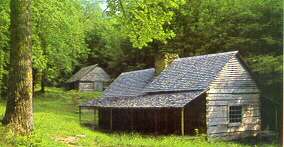Echoes From The Past
By JUDY MAUPIN
*- Echoes From the Past
(A Column of historical and genealogical anecdotes, stories and family notes.)
Calloway County, Ky.
Hunting Iron Furnace
June 28, 1979
An Interest I have had, along with
other history buffs, is trying to find the locations of now-extinct Iron furnaces.
Getting out In the country and looking for clues that point to signs of long-ago residents is kind of like a detective story, only better. You can combine a love of the outdoors with natural curiosity and an interest In the past.
The first (and sometimes the only) clue to lead one to believe that he Is nearing an Iron furnace site is chunks of slag, that blue-green rock that was the deposit left after the Iron had been made. Of course, this can be a misleading clue, because in some areas this rock was hauled off and used to pave muddy country roads. But It usually means that you are In the right area.
For those of you who might care to spend a Saturday or Sunday afternoon In this way, I will list some of the known furnaces in this area, with general
clues as to thsir locations. The rest Is up to you.
The closest furnace to Murray would have to be the Girard Furnace. There is a historical marker on South 121, below
New Concord which describes this site.
I haven't hunted Its exact location, but
it is believed to be on past the big
quarry off the Hope Church road, on the other side of the quarry. Therels a large amount of limonite to be found In that area. Umonite Is the iron rock, often found In hollow nodules which are
fortified with a talcum4ine powder. It Is said that the Indians took this powder and mixed it with bear grease to use as war paint.
There were several iron furnaces between the rivers, two of which have
been preserved - Great Western
furnace at Model, Tennessee, and Center Furnace, near LBL's Conservation-Education station.
Mammoth Furnace, built about 184$,
is located five miles south of Eddyville, on Little Hurricane Creek. Very little Is known about It, including the exact location. Peytona Furnace was built In
1847. This one is said to have been the
object of heavy firing during the Civil War, being on the road between Fort Donelson and Fort Henry. It was built on Bear Creek, somewhere just north of the road between Dover and Paris.
The Iron Mountain Furnace was located about six miles south of Great Western Furnace In the vicinity of the site of the former community of Tharpe, between the rivers. It was built in 1854. This furnace was still in operation as late as 1882, so it is possible that there are still some recognizable traces left.
Laura Furnace also has a historical marker, although It Is not very close to the actual site. It is near Ford's Bay, between the rivers, and was in operation from about 1855 to 1872. There Is a lot of blue slag In that area, but it Is possible that the actual site of the furnace is now covered by the waters of Lake Barkley.
Trigg Furnace is located in Trigg County, about eight miles north of Canton. There is a historical marker along the side of the highway near the Old Cunningham or Trigg Furnace Cemetery. I don't know the dates of its operation, but it is supposed to have been a very large furnace and I believe there are recognizable ruins there.
Empire Iron Furnace was built on the south bank of the Cumberland River in 1843. I believe it was some five miles north of Center Furnace. Another three miles further north was the Fulton
Furnace, built in 1845. Its location might be pinpointed by finding the sit of the rolling mills at Rock Castle an~ measuring two miles due east.
Although I have never tried to find it or Its approximate location, Sewane Furnace Is in Lyon County, somewhere north of the canal that connects the two lakes.
If you decide that you'd like to do i little modern archaeology, be prepared to wade through weeds and berry bushes, climb some hills, and even possibly, enjoy yourself. You can stand there and picture what It must have been like, one hundred or more year ago, with the workers at the furnace slaves many times, and the other activlties which were part of the scene Next week, I will describe the process of making Iron as ft was done around here.

